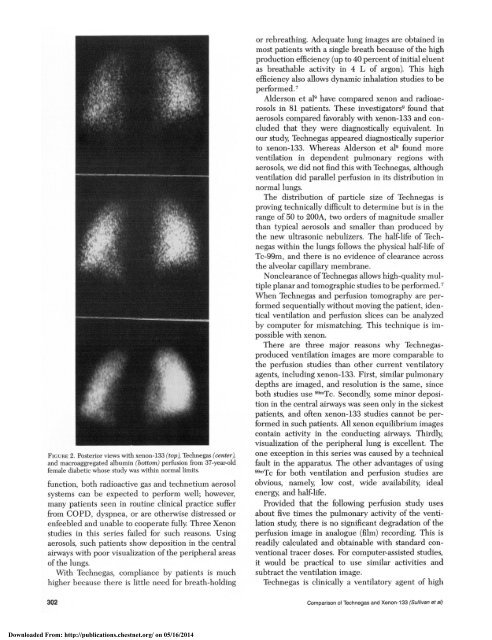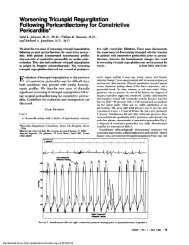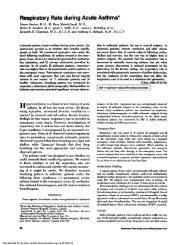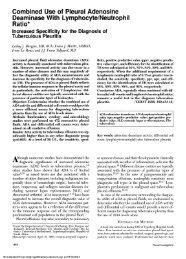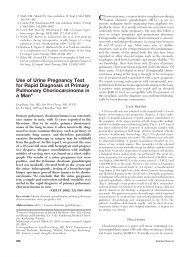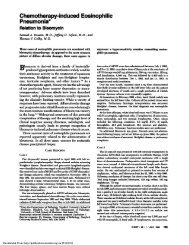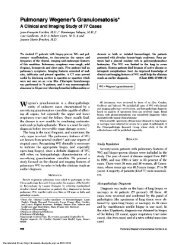A Clinical Comparison of Technegas and Xenon-133 in 50 Patients ...
A Clinical Comparison of Technegas and Xenon-133 in 50 Patients ...
A Clinical Comparison of Technegas and Xenon-133 in 50 Patients ...
You also want an ePaper? Increase the reach of your titles
YUMPU automatically turns print PDFs into web optimized ePapers that Google loves.
FIGURE 2. Posterior views with xenon-<strong>133</strong> (top), <strong>Technegas</strong> (center),<br />
<strong>and</strong> macroaggregated album<strong>in</strong> (bottom) perfusion from 37-year-old<br />
female diabetic whose study was with<strong>in</strong> normal limits.<br />
function, both radioactive gas <strong>and</strong> technetium aerosol<br />
systems can be expected to perform well; however,<br />
many patients seen <strong>in</strong> rout<strong>in</strong>e cl<strong>in</strong>ical practice suffer<br />
from COPD, dyspnea, or are otherwise distressed or<br />
enfeebled <strong>and</strong> unable to cooperate fully Three <strong>Xenon</strong><br />
studies <strong>in</strong> this series failed for such reasons. Us<strong>in</strong>g<br />
aerosols, such patients show deposition <strong>in</strong> the central<br />
airways with poor visualization <strong>of</strong> the peripheral areas<br />
<strong>of</strong> the lungs.<br />
With <strong>Technegas</strong>, compliance by patients is much<br />
higher because there is little need for breath-hold<strong>in</strong>g<br />
302<br />
or rebreath<strong>in</strong>g. Adequate lung images are obta<strong>in</strong>ed <strong>in</strong><br />
most patients with a s<strong>in</strong>gle breath because <strong>of</strong> the high<br />
production efficiency (up to 40 percent <strong>of</strong> <strong>in</strong>itial eluent<br />
as breathable activity <strong>in</strong> 4 L <strong>of</strong> argon). This high<br />
efficiency also allows dynamic <strong>in</strong>halation studies to be<br />
performed.7<br />
Alderson et al have compared xenon <strong>and</strong> radioaerosols<br />
<strong>in</strong> 81 patients. These <strong>in</strong>vestigators9 found that<br />
aerosols compared favorably with xenon-<strong>133</strong> <strong>and</strong> concluded<br />
that they were diagnostically equivalent. In<br />
our study <strong>Technegas</strong> appeared diagnostically superior<br />
to xenon-<strong>133</strong>. Whereas Alderson et a19 found more<br />
ventilation <strong>in</strong> dependent pulmonary regions with<br />
aerosols, we did not f<strong>in</strong>d this with <strong>Technegas</strong>, although<br />
ventilation did parallel perfusion <strong>in</strong> its distribution <strong>in</strong><br />
normal lungs.<br />
The distribution <strong>of</strong> particle size <strong>of</strong> <strong>Technegas</strong> is<br />
prov<strong>in</strong>g technically difficult to determ<strong>in</strong>e but is <strong>in</strong> the<br />
range <strong>of</strong> <strong>50</strong> to 200A, two orders <strong>of</strong> magnitude smaller<br />
than typical aerosols <strong>and</strong> smaller than produced by<br />
the new ultrasonic nebulizers. The half-life <strong>of</strong> <strong>Technegas</strong><br />
with<strong>in</strong> the lungs follows the physical half-life <strong>of</strong><br />
Tc-99m, <strong>and</strong> there is no evidence <strong>of</strong> clearance across<br />
the alveolar capillary membrane.<br />
Nonclearance <strong>of</strong> <strong>Technegas</strong> allows high-quality multiple<br />
planar <strong>and</strong> tomographic studies to be performed.7<br />
When <strong>Technegas</strong> <strong>and</strong> perfusion tomography are performed<br />
sequentially without mov<strong>in</strong>g the patient, identical<br />
ventilation <strong>and</strong> perfusion slices can be analyzed<br />
by computer for mismatch<strong>in</strong>g. This technique is impossible<br />
with xenon.<br />
There are three major reasons why <strong>Technegas</strong>produced<br />
ventilation images are more comparable to<br />
the perfusion studies than other current ventilatory<br />
agents, <strong>in</strong>clud<strong>in</strong>g xenon-<strong>133</strong>. First, similar pulmonary<br />
depths are imaged, <strong>and</strong> resolution is the same, s<strong>in</strong>ce<br />
both studies use 9omTc. Secondly, some m<strong>in</strong>or deposition<br />
<strong>in</strong> the central airways was seen only <strong>in</strong> the sickest<br />
patients, <strong>and</strong> <strong>of</strong>ten xenon-<strong>133</strong> studies cannot be performed<br />
<strong>in</strong> such patients. All xenon equilibrium images<br />
conta<strong>in</strong> activity <strong>in</strong> the conduct<strong>in</strong>g airways. Thirdly,<br />
visualization <strong>of</strong> the peripheral lung is excellent. The<br />
one exception <strong>in</strong> this series was caused by a technical<br />
fault <strong>in</strong> the apparatus.<br />
The other advantages <strong>of</strong> us<strong>in</strong>g<br />
aOmTc for both ventilation <strong>and</strong> perfusion studies are<br />
obvious, namely low cost, wide availability, ideal<br />
energy, <strong>and</strong> half-life.<br />
Provided that the follow<strong>in</strong>g perfusion study uses<br />
about five times the pulmonary activity <strong>of</strong> the ventilation<br />
study, there is no significant degradation <strong>of</strong> the<br />
perfusion image <strong>in</strong> analogue (film) record<strong>in</strong>g. This is<br />
readily calculated <strong>and</strong> obta<strong>in</strong>able with st<strong>and</strong>ard conventional<br />
tracer doses. For computer-assisted studies,<br />
it would be practical to use similar activities <strong>and</strong><br />
subtract the ventilation image.<br />
<strong>Technegas</strong> is cl<strong>in</strong>ically a ventilatory agent <strong>of</strong> high<br />
302<strong>Comparison</strong> <strong>of</strong> <strong>Technegas</strong> <strong>and</strong> <strong>Xenon</strong> -<strong>133</strong> (Sullivan et al)<br />
Downloaded From: http://publications.chestnet.org/ on 05/16/2014


